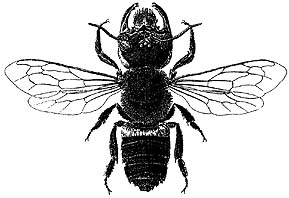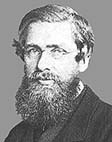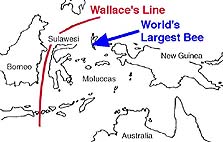Home
Aussie Bee Online
Welcome
New Articles
About Native Bees
Bee Photo Gallery
Bees in Your Area
Common Questions
Rescuing Native Bees
Exotic Bumblebees
What are Stingless Bees?
Buying Stingless Bees
Honey Production
Crop Pollination
Study Native Bees
Field Guide
Information Booklets
Tim Heard's Book
John Klumpp's Book
Aussie Bee Back Issues
Seminars
Links
Support Native Bees
Aussie Bee Shop
Order Form
Who We Are
Donations
Privacy Policy
Free Newsletter
Website Survey
Download Printer-Friendly PDF version of this article
The LARGEST Bee in the World
Dr Anne Dollin
Australian Native Bee Research Centre
November 2001
In 1859 a massive bee was found in the jungles of Indonesia by the famous naturalist, Alfred Russel Wallace. No further trace was found of it for 120 years and it was believed to be extinct. Then amazingly, Wallace’s long-lost bee was rediscovered. This was Megachile pluto, the world’s largest bee.
 |
The First Discovery
Alfred Russel Wallace spent eight years, from 1854 to 1862, exploring the little known wildlife of the Malay Archipelago (13,000 islands now in Malaysia and Indonesia). He collected an astonishing 125,660 specimens, including 83,200 beetles. Over 1,000 of the species he collected were new to science.
In 1859 Wallace found a single female of the world’s largest bee on the island of Bacan in the North Moluccas, Indonesia. So spectacular had been Wallace’s mammal, bird and insect collections in the region that he barely seemed impressed with this remarkable bee. In his famous book about his journey, The Malay Archipelago (1869), he simply recorded his discovery as, ‘a large black wasp-like insect, with immense jaws like a stag-beetle.’ The British Museum entomologist, Frederick Smith, however, had a greater appreciation of this bee’s significance. In his scientific description of the bee in 1860 he wrote, ‘This species is the giant of the genus to which it belongs, and is the grandest addition which Wallace has made to our knowledge of the family Apidae.’
Disappearance and Rediscovery
There were no further reports of this huge bee for over one hundred years. With forestry activities on Bacan, it was feared the bee could become extinct before any more were found. Then in 1981 an American biologist, Adam Messer, discovered six nests on Bacan and adjoining islands (see J Kansas Ent Soc, 1984, 57: 165–168). The bee was so rare that locals had never seen the nests before.
A True Giant Amongst Bees!
Australia claims to have the smallest bees in the world – the 1.8 mm (1/16 inch) long Quasihesma bees of Cape York, Queensland (see Aussie Bee Issue 4). In contrast, these giant Indonesian Megachile bees (previously called Chalicodoma) measure 39 mm (just over 1 1/2 inches) long and are nearly 22 times larger!
The Megachile pluto female has a wingspan of 63 mm (2 1/2 inches)! Her massive head is 13 mm (1/2 inch) wide and she has enormous pointy jaws. The species is a variety of resin bee (see Aussie Bee Issue 5) and she uses these jaws to gather resin for her nest. Adam Messer discovered that she scrapes a ball of resin together with her jaws then rolls it forwards along the tree trunk using a special elongated plate on her face like a bulldozer blade. She continues rolling the ball back and forth until it is about 10 mm wide. She then flies back to her nest with the resin ball in her jaws.
A Bee Nest Inside a Treetop Termite Nest
All the bee nests which Adam found were hidden inside active nests of termites
(Microcerotermes). These termites build nests from a chewed wood material in the trunks and branches of forest trees.
There were up to six female bees in each nest. Adam found that the bees build a horizontal entrance tunnel opening into a vertical main tunnel which is wide enough to allow two females to pass each other. Horizontal cells for the brood are built off the main tunnel. The largest nest Adam studied had 157 brood cells although only 25 were in use. The rest were sealed up and abandoned.
Adam found that the female bee also collects bundles of wood fibres for nest building and carries them back to her nest in her jaws. She constructs tunnels and cells by mixing the wood particles with resin. The mixture hardens into a black waterproof material that seals the termites out of the bee’s nest.
The Midget Male
The Megachile pluto male looks puny beside the female and is only 23 mm (9/10 inch) long. Adam did not find any males inside the nests. Instead the males were perched on vines near resin sources or near the nest, darting off to pursue a female or chase away an intruding male.
Megachile pluto was brought to our attention by Aussie Bee member David Kinnell. May this extraordinary native bee long continue to survive in the tropical jungles of Indonesia!
|
Aussie Bee Online Fact File Alfred Russel Wallace (1823-1913) . |
||||
| This English naturalist was one of the fathers of modern science. From 1848 to 1852 he explored and collected in the Amazon River basin, only to lose almost his entire collection and most of his notes when his ship went up in flames and then sank on his return voyage. Wallace and his comrades were finally rescued after ten days at sea in badly leaking lifeboats. Despite this, Wallace still managed to publish articles, books and a map which won him acclaim from the Royal Geographical Society. |
 |
|||
| From 1854 to 1862 Wallace explored the Malay Archipelago, carrying out about 70 expeditions and travelling over 22,000 km. He collected 125,660 specimens, including 212 new species of birds, 900 new species of beetles and 200 new species of ants. Wallace’s observations led him to discover a boundary line which separates the very different animal-life of the Australasian and Asian regions. This boundary line became known as Wallace’s Line. |
||||
 |
||||
| . While in the Moluccas in 1858 Wallace wrote an essay about the development of new species which would ensure his place in history. Wallace is credited, along with Charles Darwin, for discovering the theory of evolution by natural selection. |
||||
.
• Download the PDF version of this article.
(If you have not used PDF before, click here.)
• For more interesting Aussie Bee Online articles on native bees, visit the contents
Author: Anne Dollin
(See Anne Dollin's Google+ profile)
|
Please feel free to print out this article or to email copies of the PDF version to your friends. This article may also be reproduced or hosted on other websites providing it is kept in its full and unaltered form including ANBRC contact details.
|
.Search Aussie Bee Website:
© 1997-2018 Australian Native Bee Research Centre
PO Box 74, North Richmond NSW 2754, Australia